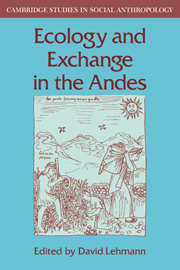Book contents
- Frontmatter
- Contents
- List of contributors
- Acknowledgements
- The Andean region: relief
- The Andrean region showing ecological levels (after Troll 1968)
- 1 Introduction: Andean societies and the theory of peasant economy
- 2 The role of the Andean ayllu in the reproduction of the petty commodity regime in Northern Potosí (Bolivia)
- 3 Labour and produce in an ethnic economy, Northern Potosi, Bolivia
- 4 ‘Resistance to capitalism’ in the Peruvian Andes
- 5 Production and market exchange in peasant economies: the case of the southern highlands in Peru
- 6 The Andean economic system and capitalism
- 7 Property and ideology: a regional oligarchy in the Central Andes in the nineteenth century
- 8 Multi-levelled Andean society and market exchange: the case of Yucay (Peru)
- Glossary
- References
- Index
- Cambridge Studies in Social Anthropology
2 - The role of the Andean ayllu in the reproduction of the petty commodity regime in Northern Potosí (Bolivia)
Published online by Cambridge University Press: 29 September 2009
- Frontmatter
- Contents
- List of contributors
- Acknowledgements
- The Andean region: relief
- The Andrean region showing ecological levels (after Troll 1968)
- 1 Introduction: Andean societies and the theory of peasant economy
- 2 The role of the Andean ayllu in the reproduction of the petty commodity regime in Northern Potosí (Bolivia)
- 3 Labour and produce in an ethnic economy, Northern Potosi, Bolivia
- 4 ‘Resistance to capitalism’ in the Peruvian Andes
- 5 Production and market exchange in peasant economies: the case of the southern highlands in Peru
- 6 The Andean economic system and capitalism
- 7 Property and ideology: a regional oligarchy in the Central Andes in the nineteenth century
- 8 Multi-levelled Andean society and market exchange: the case of Yucay (Peru)
- Glossary
- References
- Index
- Cambridge Studies in Social Anthropology
Summary
Introduction
The north of the Department of Potosí – formerly the Province of Chayanta – has long been considered one of the most ‘traditional’ regions of highland Bolivia, supposedly ‘subsisting’ at the fringes both of the market and of effective state control. This apparent marginality of the regional peasant economy contrasts with the great mining complexes which have developed in its midst: Colquechaca and Aullagas, during the colonial and nineteenthcentury silver era; and more recently the massive tin-mining centre of Catavi–Siglo XX–Uncia. This chapter represents part of a research project (see Notes), which attempted to examine the forms of articulation by which regional peasant households, grouped into a complex hierarchy of ‘communities’ or ayllus, are in fact linked with both labour and product markets. This also meant examining the possibilities for accumulation that exist within the Andean peasant economy of Northern Potosí. Thus one point of departure has been the search for quantitative data in order to test the empirical basis of the dualistic scheme, which opposes the mining ‘enclave’ to the ‘subsistence economy’ of the Andean peasant.
However, the synchronic application of this dualistic model disguises what is effectively a negation of history. In contrast with the northern altiplano of La Paz, Northern Potosi is remarkable for the small success which hacendados – above all, from Chuquisaca – had in expanding into the region prior to the Revolution of 1952.
- Type
- Chapter
- Information
- Ecology and Exchange in the Andes , pp. 27 - 69Publisher: Cambridge University PressPrint publication year: 1982
- 22
- Cited by



